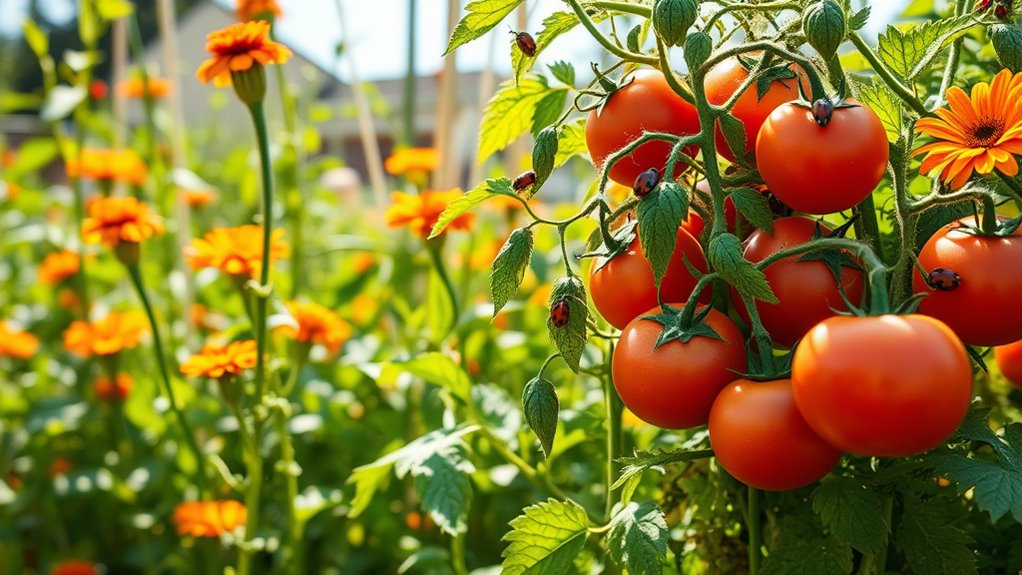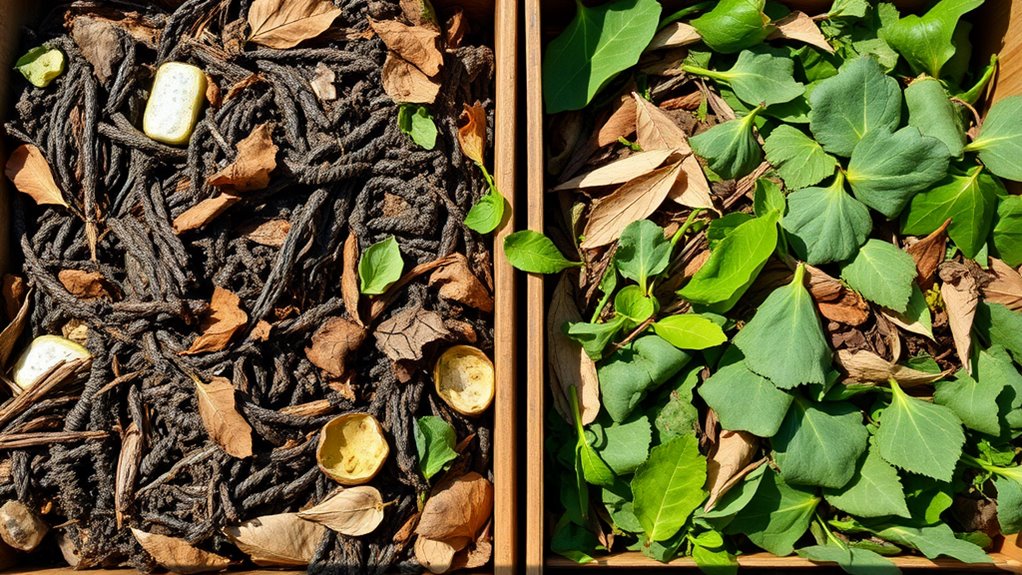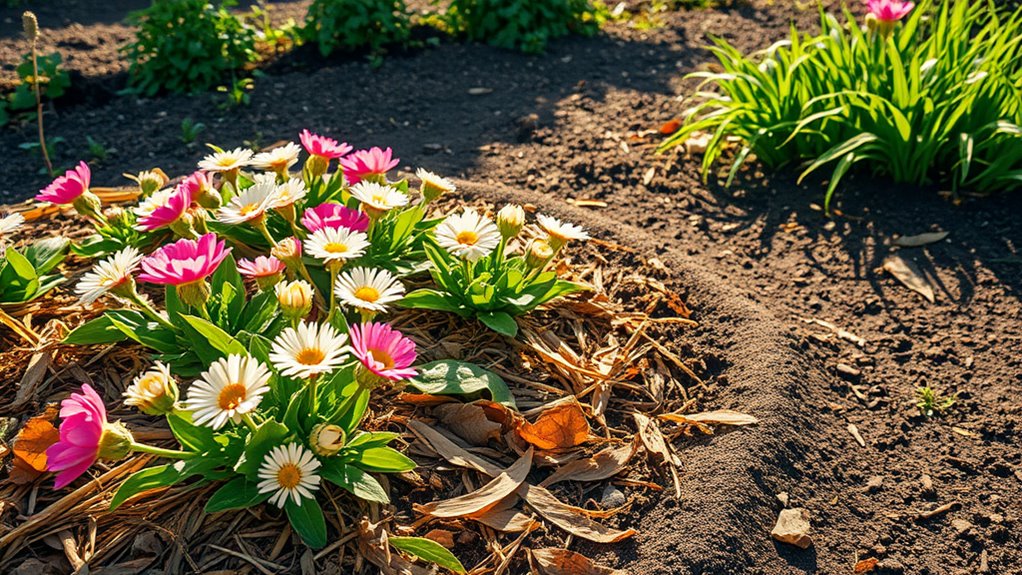How I Made My Garden Pest-Free Without Spending a Dime
You can make your garden pest-free without spending a dime by inspecting plants daily and manually removing pests like aphids or caterpillars. Plant companions such as marigolds with tomatoes to naturally repel insects, and craft DIY traps from household items like jars and fruit. Attract beneficial bugs with diverse flowers and enhance soil health through composting and crop rotation. These strategies build a resilient ecosystem, so keep exploring for even more proven techniques.
Key Takeaways
- Inspect plants daily and manually remove pests like aphids by crushing or drowning them in soapy water.
- Plant companion species, such as marigolds near tomatoes, to naturally repel insects without cost.
- Build DIY traps using recycled jars and overripe fruit as bait to capture and eliminate pests.
- Use companion planting techniques, like basil with peppers, to attract beneficial insects for natural control.
- Rotate crops annually and monitor pest patterns through a simple journal to prevent future infestations.
Identifying Common Garden Pests
To keep your garden thriving, start by identifying common pests like aphids, slugs, and caterpillars, which can quickly damage plants if left unchecked.
You spot aphids as tiny, green clusters on stems and leaves; slugs by their slimy trails and chewed foliage; and caterpillars by holes in leaves or their distinctive bodies.
For effective DIY pest control, inspect plants daily, especially in the early morning or evening. Early detection lets you intervene simply, using household items to manage outbreaks without chemicals, keeping your space healthy and cost-effective. Moreover, utilizing natural herbs can help deter pests like aphids and caterpillars naturally.
Stay vigilant for a pest-free haven.
Additionally, exploring the top five pests can provide further insights into effective management strategies to protect your garden.
Natural Barriers for Pest Prevention
Natural barriers offer an effective way to shield your garden from pests without relying on chemicals. You can plant companion species like marigolds or chives, which naturally repel insects with their strong scents.
Build physical defenses using dense rows of herbs or thorny bushes to block access points. Apply organic mulches, such as straw or leaves, to disrupt pest movement on the soil surface.
Strategically rotate these barriers seasonally to adapt to pest patterns, ensuring long-term protection. You’ll foster a balanced ecosystem that keeps invaders at bay, saving your plants effortlessly. Furthermore, these strategies embody cost-effective methods that require no financial investment.
Always observe and refine your setup for optimal results. To maximize effectiveness, consider using easily accessible staples like common household items to bolster your natural defenses.
DIY Traps From Everyday Items
You’ll find that making DIY traps from everyday items, like a homemade fly trap, puts you in control of pesky insects without buying fancy gear.
A recycled jar snare offers a simple, effective way to capture other garden pests using things you already have.
Let’s explore how these traps work and how you can build them quickly. By using organic ingredients, you can enhance their effectiveness for a healthier garden.
These DIY traps align with unconventional remedies that emphasize natural pest control to avoid harsh chemicals.
Homemade Fly Trap
If flies are buzzing around your garden, making a simple homemade trap from everyday items like bottles and sugar can quickly lure and capture them. You’ll need just a few household basics to build it effectively. Start by cutting a plastic bottle and inverting the top to create a funnel trap.
| Material | How to Use |
|---|---|
| Plastic bottle | Cut and invert to form a funnel. |
| Sugar | Mix with water for sweet bait. |
| Dish soap | Add a drop to break surface tension. |
| String | Tie to hang the trap securely. |
This method traps flies without harming beneficial insects, keeping your garden pest-free effortlessly.
Recycled Jar Snare
Transform an old jar into a simple snare to tackle garden pests effectively.
You’ll gather an old jar, bait like overripe fruit, and a bit of dish soap.
Drill small entry holes near the top or remove the lid partially to lure pests in while trapping them.
Bait the bottom with your mixture, then position the jar in pest-heavy spots.
Pests enter for the allure but can’t escape, drowning quickly.
Empty it daily to maintain hygiene and effectiveness.
This cost-free method targets slugs, beetles, and more, keeping your garden thriving without chemicals.
Experiment for best results.
Companion Planting Techniques
You can enhance your garden’s pest resistance by using companion planting techniques that pair plants strategically.
Start with pest-repelling pairs like marigolds and tomatoes to deter common insects naturally.
Explore beneficial plant combos and strategic garden allies to build a thriving, balanced ecosystem that keeps pests in check. Additionally, leveraging scientific principles behind these pairings can lead to more effective pest management and improved plant vitality.
Moreover, these techniques can increase crop yields while enhancing overall garden health.
Pest-Repelling Pairs
Companion planting harnesses pest-repelling pairs to naturally deter garden invaders, making it a practical strategy for maintaining a thriving, chemical-free space.
You pair plants like marigolds with tomatoes to ward off nematodes, or basil alongside peppers to repel aphids, creating a defensive barrier.
Strategically, you interplant these companions in your garden beds, ensuring they’re close enough to interfere with pests’ senses.
Observe your garden’s layout; rotate pairs annually to prevent pest adaptation.
This method saves money while boosting your plants’ resilience—try it and watch invasions dwindle.
Stay vigilant for optimal results.
Beneficial Plant Combos
As you explore beneficial plant combos in companion planting, you’ll quickly see how strategic pairings boost growth and ward off threats.
For instance, plant marigolds alongside tomatoes; their roots release compounds that deter nematodes while attracting pollinators.
Pair basil with peppers to repel aphids and enhance flavors through natural oils.
Try beans with corn and squash in a Three Sisters setup: beans fix nitrogen, corn provides support, and squash shades weeds.
These free, simple techniques maximize space, improve soil health, and create a resilient, pest-resistant garden you can maintain effortlessly.
Experiment with these combos for thriving results.
Strategic Garden Allies
Strategic garden allies leverage companion planting to naturally shield your garden from pests and promote healthy growth.
You’ll pair plants strategically; for instance, plant marigolds near tomatoes to repel nematodes, or basil beside peppers to deter aphids. This method confuses pests and enhances soil nutrients without any cost.
Actively rotate companions each season to maintain balance and avoid pest buildup. You’re building a resilient ecosystem where plants support each other, boosting yields and vitality.
Experiment with combos like garlic around roses to ward off beetles, ensuring your garden thrives naturally and sustainably.
Attracting Beneficial Insects
Beneficial insects, such as ladybugs and lacewings, play a key role in your garden’s pest control, so you’ll want to draw them in naturally to keep harmful bugs at bay.
To attract these allies, plant diverse flowers like marigolds, daisies, and fennel, which provide nectar and pollen as food sources.
Leave some wild areas with untidy corners for shelter and overwintering.
Avoid broad-spectrum pesticides that kill beneficial bugs.
Introduce native plants to create a balanced ecosystem, ensuring ladybugs and lacewings thrive and multiply, naturally managing aphids and other pests without any cost. Additionally, these practices support eco-friendly methods by minimizing environmental harm and fostering sustainable gardening.
Stay patient; results build over time.
Drawing from my initial foray into companion planting, I discovered it can further amplify these natural pest control methods by strategically pairing plants.
Homemade Repellents From Kitchen Scraps
While pests threaten your garden, you can whip up simple repellents from kitchen scraps to deter them effectively.
Begin with garlic: mince a few cloves, steep in water overnight, strain, and spray on leaves to repel aphids and mites naturally.
For tougher pests like caterpillars, blend chili peppers with water, let it ferment, then apply as a spray—it’s a fiery deterrent they hate.
Use onion skins boiled in water for a rinse that keeps beetles at bay, or mix vinegar with citrus peels to create an ant-repelling solution.
Apply these weekly for best results; they’re safe, effective, and cost-free, drawing on your kitchen’s hidden arsenal to protect your plants without chemicals. These natural repellents can also complement eco-friendly weed control strategies to maintain a thriving garden overall.
Always test on a small area first.
Based on my personal experience with these natural methods, they’ve proven highly effective in maintaining a pest-free garden.
Soil Health Strategies for Pest Resistance
Beyond pests and repellents, nurturing your garden’s soil builds a strong defense against infestations. Healthy soil fosters resilient plants that naturally ward off pests, reducing the need for interventions.
Focus on enhancing soil structure and nutrients to create an unwelcoming environment for bugs.
-
Compost organic waste: Turn kitchen scraps into nutrient-rich soil amendments that boost microbial activity and plant vigor.
-
Mulch with leaves: Apply a thick layer to retain moisture, regulate temperature, and smother weed hosts for pests.
-
Rotate your crops: Change planting locations annually to break pest life cycles and maintain soil fertility.
-
Test and balance pH: Regularly check soil acidity and add lime or sulfur to optimize conditions for healthy roots.
-
Incorporate cover crops: Plant nitrogen-fixing species like clover to improve soil texture and deter harmful insects.
Manual Removal and Physical Methods
After enhancing your soil’s health, you can tackle pests head-on by manually removing them and using physical barriers.
Inspect your plants daily and pick off insects like aphids or caterpillars by hand, then crush or drown them in soapy water you’ve mixed at home.
For barriers, wrap row covers from old sheets around vulnerable crops to block pests, or place overturned containers as traps for slugs.
These methods disrupt infestations quickly and build your garden’s defenses through direct action.
Long-Term Monitoring for Pest Control
To keep your garden thriving without ongoing pest threats, you’ll need to establish a routine for long-term monitoring. This proactive strategy helps you spot issues early, using simple observations to maintain a balanced ecosystem without costs.
-
Inspect plants weekly for subtle signs like holes or discoloration.
-
Keep a basic journal to track pest patterns and trends over seasons.
-
Observe beneficial insects, such as ladybugs, to gauge natural control.
-
Monitor weather and soil conditions that might invite pests.
-
Adjust your routine seasonally, focusing on high-risk periods for prevention.





